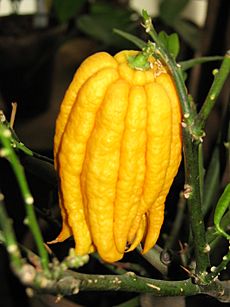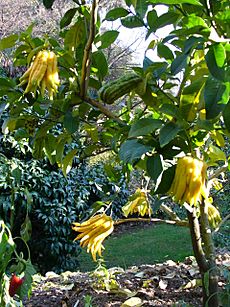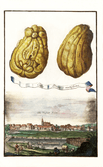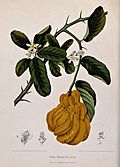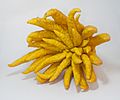Buddha's hand facts for kids
Quick facts for kids Buddha's hand |
|
|---|---|
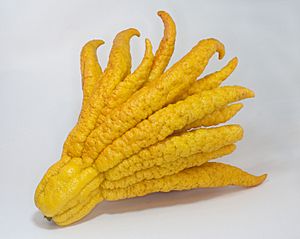 |
|
| Buddha's hand fruit, "open hand" appearance when ripe | |
| Scientific classification | |
| Kingdom: | |
| (unranked): | |
| (unranked): | |
| (unranked): | |
| Order: | |
| Family: | |
| Genus: | |
| Species: | |
| Trinomial name | |
| Citrus medica var. sarcodactylis (Siebold ex Hoola van Nooten) Swingle
|
|
The Buddha's hand fruit is a unique type of citron. It gets its name because it looks like fingers, similar to how the hand of Buddha is often shown. Its scientific name is Citrus medica var. sarcodactylis. People in China, Japan, and Korea also call it Buddha's hand.
This special citron comes in different shapes. Some fruits have "fingers" that spread out like an open hand. Others have fingers that stay together, like a closed hand. There are also fruits with fingers only on one side. This fruit likely first grew in South or East Asia, possibly in northeastern India or China. This is where many types of citrus fruits began.
Contents
What is Buddha's Hand Used For?
The Buddha's hand fruit has many interesting uses. It is known for its strong, pleasant smell. It is also used in religious ceremonies and as a decorative plant.
Making Things Smell Nice
The Buddha's hand fruit smells very good. People in China, Malaysia, and Japan use it to make rooms smell fresh. They also use it to perfume personal items, like clothes.
Religious Meanings
This fruit is often given as a religious offering in Buddhist temples. Tradition says that Buddha prefers the fruit's "fingers" to be closed. This is because closed hands can symbolize prayer. In China, the Buddha's hand fruit is a sign of happiness, long life, and good luck. It is also a common gift for the New Year.
Growing as a Decoration
The fingered citron is grown as an ornamental tree. People plant it in gardens and in pots on patios and terraces. It adds a unique look to outdoor spaces.
Food and Traditional Medicine
Most types of Buddha's hand fruit do not have much pulp or juice. People value it for its beautiful shape and smell. However, you can still eat it! It is often used as a zest or flavor in desserts. It can also be added to savory dishes or alcoholic drinks like vodka. Sometimes, it is candied to make a sweet treat. The dried peel of young fruits is also used in traditional medicine as a tonic.
What Does Buddha's Hand Look Like?
The Buddha's hand plant is a shrub or a small tree. It has long, uneven branches with thorns. Its large, oval leaves are pale green and grow about 10 to 15 centimeters long. The white flowers have a purplish tint on the outside. They grow in fragrant groups.
The fruit's "fingers" are mostly the white part of the fruit. Sometimes, they have a small amount of sour pulp. Many fruits have no juice at all, and some have no seeds.
This plant does not like very cold weather (frost). It also struggles with intense heat and dry conditions. It grows best in a mild climate. New trees can be grown from cuttings taken from older branches. It is also often grafted onto other strong root systems.
Images for kids
-
Cross section in a Variety etrog citron, and in fingered citron
See also
 In Spanish: Mano de buda para niños
In Spanish: Mano de buda para niños


